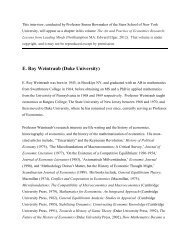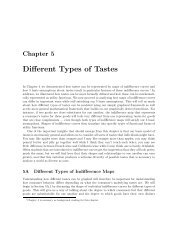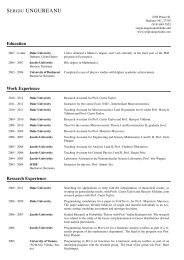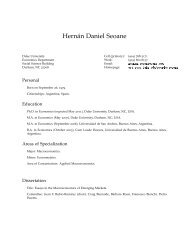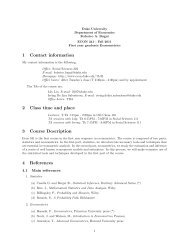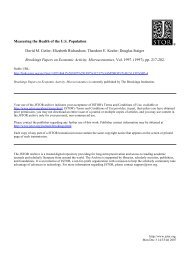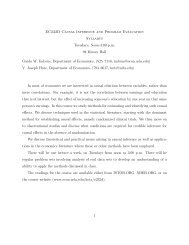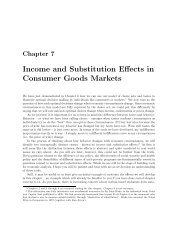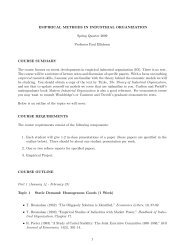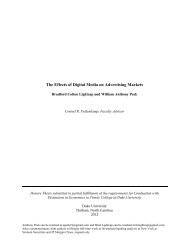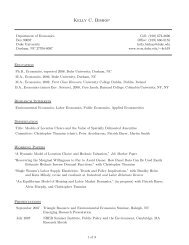Is Talk Cheap? - Duke University | Economics
Is Talk Cheap? - Duke University | Economics
Is Talk Cheap? - Duke University | Economics
- TAGS
- economics
- econ.duke.edu
Create successful ePaper yourself
Turn your PDF publications into a flip-book with our unique Google optimized e-Paper software.
“A Statesman is the animal who works with phrases instead of with the burglar’s jimmy.”<br />
“Why form a party when you can as well form a pressure group?”<br />
“Politicians are like bad horsemen who are so preoccupied with keeping in the saddle that they can’t bother<br />
about where they go.”<br />
--Some of Joseph A. Shumpeter’s aphorisms drawn from Swedberg (1991).<br />
<strong>Is</strong> <strong>Talk</strong> <strong>Cheap</strong>?<br />
Buying Congressional Testimony with Campaign Contributions *<br />
Ryan Gibbs, a Omer Gokcekus b and Edward Tower a<br />
a <strong>Duke</strong> <strong>University</strong> and b North Carolina Central <strong>University</strong><br />
The Journal of Policy Reform, Volume 5, issue 3, 2002, 127-132 (lead article)<br />
April 9, 2003<br />
Abstract: For the steel import quota bill of 1999, our answer to the question posed in the<br />
title is that each word in the Congressional Record costs $39 in campaign contributions<br />
from the steel industry. Consequently, our answer is “Yes.”<br />
JEL Classification: F13<br />
* The authors’ emails are respectively zotch812@yahoo.com, ogokceku@wpo.nccu.edu, and<br />
tower@econ.duke.edu. For Correspondence: Omer Gokcekus, School of Business, North<br />
Carolina Central <strong>University</strong>, Durham, NC 27707; Telephone: 919-530-7393, or Edward Tower,<br />
<strong>Duke</strong> <strong>University</strong>, Department of <strong>Economics</strong>, Durham, NC 27708; Telephone: 919-660-1818.<br />
Thanks go to Mike Connolly, Dave Feldman, Christof Galli, Tyler Gellasch, Mia Mikic, Olga<br />
Mossina, Ken Reinker, Pasquale Sgro and Erin Westrup for helpful comments.
<strong>Is</strong> <strong>Talk</strong> <strong>Cheap</strong>? Buying Congressional Testimony with Campaign Contributions<br />
1 INTRODUCTION<br />
Gordon Tullock (1967), in his marvelously insightful, elegantly simple and<br />
delightfully written essay “The Welfare Cost of Tariffs, Monopoly and Theft,” argues<br />
that in addition to the resource allocation costs of tariffs, one must consider the costs of<br />
lobbying to acquire tariffs and the costs of lobbying to prevent them from rising higher.<br />
This line of inquiry has been further pursued by Krueger (1974), Bhagwati (1982),<br />
Becker (1983), Dixit, Grossman and Helpman (1997) and others. The welfare cost of<br />
directly unproductive activities, such as efforts to influence policy hinges on a<br />
microeconomic specification of how these activities occur, along with knowledge of the<br />
shadow prices of the resources used up in these activities. Krueger provides some<br />
insightful microeconomic stories about the cost of rent seeking and presents some<br />
estimates of the cost of rent seeking. Also, a number of studies have explored how<br />
campaign contributions influence voting on trade policy: e.g. Baldwin (1985), Kaempfer<br />
and Marks (1993), Kang (1999), and the papers cited in Kaempfer, Tower and Willett<br />
(2002). But these studies consider only a few aspects of the microeconomics of rent<br />
seeking. In order to more fully draw out the implications of rent seeking behavior, we<br />
need to enrich our sense of the microeconomics of rent seeking.<br />
In this paper, we make a modest foray in looking at one additional aspect of rent<br />
seeking. Fisher, Gokcekus and Tower (2002) explore how campaign contributions to<br />
members of the U.S. House of Representatives affected their votes on a steel import<br />
quota bill, the “Bipartisan Steel Recovery Act” of 1999, H.R. 975. In the process they<br />
gathered almost all of the data necessary for us to ask two further interesting questions.<br />
Drawing on the Congressional Record, which presents a verbatum record of the debate,<br />
we ask “Did campaign contributions buy testimony on the House floor?” and “How much<br />
did each word of testimony cost?”<br />
2 THE BILL<br />
The digest of the bill, which summarizes its content, is available on Lexis-Nexis<br />
from the Congressional Research Service. It reads:<br />
1
[The bill] Directs the President to impose quotas, tariff surcharges, or negotiate<br />
enforceable voluntary export restraint agreements in order to ensure that the<br />
volume of imported steel products … during any month does not exceed the<br />
average volume of imported steel for the 36-month period preceding July 1997.<br />
…<br />
Robert Crandall in the March 19, 1999 Wall Street Journal labeled it “one of the most<br />
blatantly protectionist pieces of legislation since the 1930s.” The House debate was on<br />
May 22-23, 1999, and the vote was on May 25, 1999. The bill passed the house 250-150,<br />
but debate was never closed in the Senate, so it never became law. For more detail and<br />
some quotes from the debate, see FGT (2002).<br />
3 THE MODEL<br />
Harper and Aldrich (1990) discovered that U.S. Senators who receive large<br />
campaign contributions from sugar producers or have a large presence of sugar producers<br />
in their states tend to vote in favor of the U.S. sugar subsidy program. Symmetrically,<br />
they found that campaign contributions by sugar users, like candy makers, or a large<br />
presence of sugar users in senators’ states tend to stimulate them to vote against it.<br />
Similarly, we figured that Representatives receiving substantial contributions from steel<br />
or who have a constituency with a large representation of steel producers would be likely<br />
to offer more voluminous testimony in favor of the bill. And, we supposed that<br />
Representatives who received substantial contributions from steel users, like autos, or had<br />
a constituency with a large representation of steel users would be likely to offer more<br />
voluminous testimony against it. Accordingly, we have the following ad hoc model:<br />
Lines = f (PARTY, Auto$, Steel$, UAW$, SWA$, AW, SW).<br />
The dependent variable is Lines, the net number of lines in the Congressional Record<br />
each Representative adds to the balance of testimony. Lines carries a positive or<br />
negative sign depending on whether the testimony is for or against the bill.<br />
2
There are several independent variables. Our most important set of variables is<br />
campaign contributions to Representatives during the period January 1, 1998 through<br />
March 17, 1999, measured in thousands of dollars. These are contributions from the auto<br />
industry to Members of the U.S. House of Representatives: Auto$; from the steel<br />
industry: Steel$; from the one major steel workers’ union: SWA$; and from the one<br />
major auto workers’ union: UAW$. 1<br />
PARTY takes on a value of 1 if the Representative is a Republican and 0 if a<br />
Democrat.<br />
From the 2000 Census we have data on the number of workers employed in the steel<br />
and automobile industries, by state, measured in thousands of workers. These variables<br />
are labeled SW and AW, respectively. 2<br />
We recognize that the causality between campaign contributions and talk runs both<br />
ways. This problem cries out for a time-series analysis. Ours is a simple first pass at the<br />
problem. We attempted to duck the problem of talk causing campaign contributions by<br />
using campaign contributions from one period to explain subsequent talk.<br />
4 THE REGRESSION<br />
The following is the OLS estimation of the model.<br />
Lines = 6.74 - 1.50Auto$ + 3.19Steel$ + 0.10SWA$ - 0.51UAW$ + 0.02AW + 0.58SW - 6.99PARTY<br />
Adjusted-R 2 = 0.07<br />
F-Statistic = 5.36<br />
Degrees of freedom = 422<br />
(3.34) 3 (2.32) (0.14) (0.77) (0.58) (2.16) (1.65)<br />
1 Both the Center for Responsive Politics and the Federal Elections Commission served as sources for<br />
information on auto and steel PAC contributions. The largest PAC contributors in the auto industry were<br />
Daimler-Chrysler, Ford Motor Co, General Motors and Americans for Free International Trade. These plus<br />
Caterpillar (CAT) constitute the (AUTO) group. CAT was included because it is major steel consumer,<br />
and because of its vocal stance against H.R. 975. The steel PAC group analyzed consisted of all<br />
contributions from Acme Metals, AK Steel Corp, Allegheny Teledyne Inc., American Iron and Steel<br />
Institute, Armco Inc., LTV Steel, Lukens Inc., National Steel Corp., Standard Steel, Steel Service Center<br />
Institute, Texas Industries, WCI Steel, Weirton Steel Corp, and Wheeling-Pittsburgh Steel. The only<br />
substantial steel and auto labor PAC contributions came from the United Steelworkers of America and the<br />
United Auto Workers, the single large national steel and unions. The USWA PAC contributed only to<br />
democrats. Its contributions constitute our variable, SWA$. Their contributions constitute our variables<br />
SWA$ and UAW$. These contributions are all available on the web.<br />
2 The number of workers employed in sector 3311 constitutes steelworkers (SW), and the number of<br />
workers in sectors 3361, 3362, and 3363 constitutes autoworkers (AW).<br />
3 Numbers in parentheses are absolute t-values.<br />
3
Lines is an increasing function of contributions from the steel industry and the<br />
steelworkers’ union and a decreasing function of contributions from the auto industry and<br />
the united autoworkers’ union. It is also higher for Democrats. It rises with the number<br />
of steelworkers in the state and (anomalously) it rises with the number of autoworkers in<br />
the state, but the latter coefficient is very close to zero and insignificant. All variables are<br />
significant at the ten percent level on a two-tailed test except for the number of<br />
autoworkers and contributions from both the United Steel Workers of America and the<br />
United Autoworkers.<br />
Each dollar contributed by the steel industry is more effective than each dollar<br />
contributed by the USWA. One reason for this may be that if the steel industry is<br />
characterized as an oligopoly or monopoly, import restrictions may lower steel<br />
employment as firms opt to raise prices at the cost of production, so protection may be<br />
against the interests of steel workers. Similarly UAW contributions are less effective<br />
than auto industry contributions. So perhaps the major winners and losers from<br />
protection are the corporations rather than workers.<br />
The automobile sector is only one of many steel-using sectors. Steel is not a huge<br />
proportion of the cost of an automobile and to some extent higher steel costs can be<br />
passed onto the auto consumer. Consequently, we would expect steel import quotas to<br />
affect steel profits more profoundly than auto profits. Therefore, we are not surprised to<br />
find that contributions from autos have a smaller absolute effect than contributions from<br />
steel do.<br />
5 IS TALK CHEAP?<br />
Now we answer the question posed by the title of the paper. Each line in the<br />
Congressional Record consists of an average of 8 words. Using this conversion factor,<br />
and the estimated coefficients, we calculate that each $39 contributed by the steel<br />
industry buys one more word in favor of the bill or shrinks testimony against the bill by<br />
one word. Symmetrically, each $84 contributed by the auto industry buys one more word<br />
against the bill. Figure 1 presents the confidence intervals both for auto and steel<br />
industries’ contributions per word at the ten percent level. The probability that the true<br />
4
values of the cost/word lie within the indicated intervals is ninety percent. (The ranges<br />
are not symmetric about the point estimates because cost/word is proportional to the<br />
reciprocal of the estimated coefficients.)<br />
Figure 1 The confidence intervals for auto and steel manufacturers’ contributions per word<br />
$ Per Word<br />
$175<br />
$150<br />
$125<br />
$100<br />
$75<br />
$50<br />
$25<br />
$0<br />
$162<br />
$84<br />
$56<br />
AUTO Manufacturers<br />
(Steel Users)<br />
5<br />
$133<br />
$39<br />
$23<br />
STEEL Manufacturers<br />
(Steel Producers)<br />
6 SHOULD CAMPAIGN CONTRIBUTIONS BE OUTLAWED?<br />
We have demonstrated how campaign contributions affect congressional testimony.<br />
Lobbying is illegal in many developing countries. Does this prohibition foster better<br />
economic policy? Becker (1983) argues that lobbying tends to generate efficient policy<br />
outcomes, because lobbies will spend the greatest amount of resources in support of<br />
policies which support the largest welfare gains. But, as Kaempfer and Willett (1989)<br />
argue, this rests on the idea that all interested parties find it equally easy to mobilize
lobbying resources. And much protection and other special interest legislation rests on<br />
the unwillingness and inability of consumers and a multitude of disparate special interests<br />
to lobby against protection, leaving the balance of lobbying in favor of concentrated<br />
special interests.<br />
If lobbying is outlawed, we fear that much of it will be driven underground.<br />
Conspiracies are tricky to keep secret, so illegal activities are easier for monopolies to<br />
manage than for large organizations of small players to organize. Consequently, we<br />
believe outlawing campaign contributions is likely to raise the political power of<br />
monopolies over competitive players and further sway the political process toward<br />
protecting monopolies at the cost of competitors and consumers. Moreover, underground<br />
lobbying is harder to detect and makes the political system less transparent (and an article<br />
like this one impossible to write!). Finally, campaign contributions to some extent fund<br />
useful activities like information flows and are likely to be more socially productive than<br />
other forms of purchasing influence. A better policy than outlawing campaign<br />
contributions, we believe, is to require that any protectionism meet an economy-wide or<br />
world-wide cost benefit-test, which in practice would amount to prohibiting it.<br />
7 CONCLUSION<br />
Bhagwati (1988, p. 85) articulates what he calls the Dracula effect. Just as<br />
Dracula shrivels into nothingness when the morning sunlight hits him, “exposing evil to<br />
sunlight helps to destroy it.” He goes on to argue that clear analysis of the consequences<br />
of protectionism should help to destroy this evil. We believe that in a similar way,<br />
illuminating how money causes protection should help to destroy it. In this paper we<br />
have documented yet another way in which money from narrow special interests affects<br />
legislation: through buying debate. This we hope will strip from the case for steel<br />
protectionism a bit more of its mask of intellectual legitimacy.<br />
6
References<br />
Baldwin, R. E. (1985) Political economy of U.S. import policy. Cambridge: MIT Press.<br />
Becker, G.S. (1983) A theory of competition among pressure groups for political<br />
influence, The Quarterly Journal of <strong>Economics</strong>, 98 (August), 371-400.<br />
Bhagwati, J.N. (1982) Directly unproductive, profit-seeking (DUP) activities, Journal of<br />
Political Economy, 90 (October), 988-1002.<br />
Bhagwati, J.N. (1988) Protectionism. Cambridge: MIT Press.<br />
Dixit, A., Grossman, G.M. and Helpman, E. (1997) Common agency and coordination:<br />
General theory and application to government policy making, Journal of Political<br />
Economy, 105 (August), 752-769; reprinted as chapter 1 of Grossman, G.M. and<br />
Helpman, E. (2002). Interest groups and trade policy. Princeton: Princeton<br />
<strong>University</strong> Press.<br />
Fisher, R., Gokcekus, O. and Tower, E. (2002) Steeling house votes at low prices for the<br />
Steel Import Quota Bill of 1999. <strong>Duke</strong> <strong>Economics</strong> Working Paper #02-24:<br />
http://www.econ.duke.edu.<br />
Harper, R. K. and Aldrich, J. (1990) Political economy of sugar legislation,” Public<br />
Choice, Vol. 70, 299-314<br />
Kaempfer, W. and Willett, T.D. (1989) Combining rent seeking and public choice theory<br />
in the analysis of tariffs versus quotas, Public Choice, 63 (October), 79-86.<br />
Kaempfer, W., Tower, E. and Willett, T.D. (2002) Trade Protectionism. Forthcoming in<br />
the Encyclopedia of Public Choice Edited by Charles K. Rowley, available as<br />
<strong>Duke</strong> <strong>University</strong> Working Paper # 02-20 at http://www.econ.duke.edu.<br />
Kaempfer, W.H. and Marks, S.V. (1993) The expected effects of trade liberalization:<br />
Evidence from U.S. congressional action on fast-track authority, World Economy,<br />
16 (November), 725-40.<br />
Kang, In-B. (1999) A political economic analysis of congressional voting patterns on<br />
NAFTA, Public Choice, 98 (March), 385-397.<br />
Krueger, A.O. (1974) The political economy of the rent seeking society, American<br />
Economic Review, 64 (June), 291-303<br />
Swedberg, Richard. (1991) Schumpeter: A Bibliography. Princeton, New Jersey:<br />
Princeton <strong>University</strong> Press.<br />
Tullock, G. (1967) The welfare cost of tariffs, monopoly and theft, Western Economic<br />
Journal, 3 (June), 224-232.<br />
7



